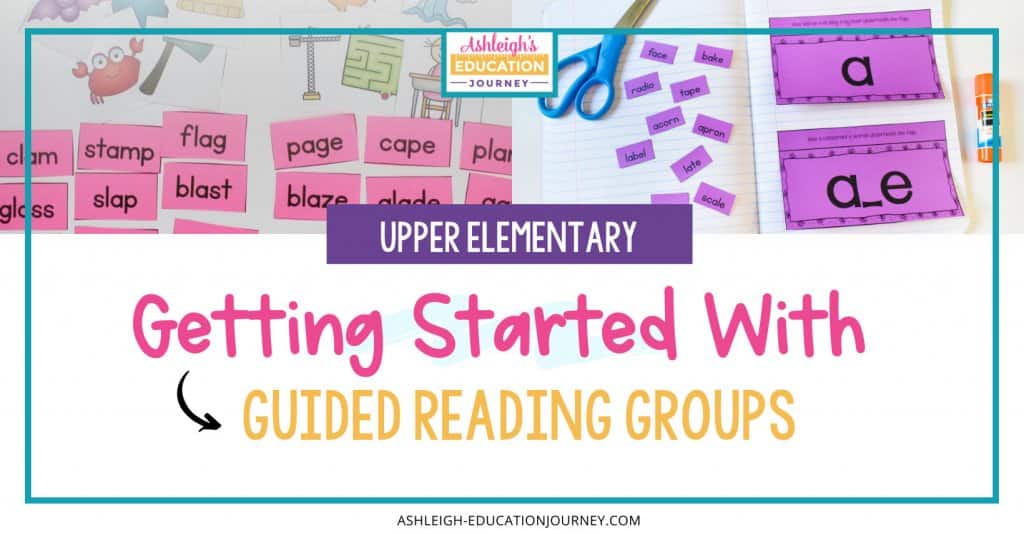
Guided reading groups are one of the most complex areas of planning and instruction. I still remember when I first started teaching thinking, “Okay, I have my groups. Now what do I do?” Hopefully, this post will be helpful to anyone who has experienced that same thought or feeling. You can read this post for a larger focus on teaching reading and gives ideas for whole group mini lessons and assessments. In this post, you’ll see how you can use the science of reading to plan your reading groups.
There is no easy fix or simple solution for implementing guided reading groups. I highly recommend the books below for professional development. I’ve pulled ideas and strategies from each book, and I’ll share an overview of what I do in my reading groups.

In this post:
- Guided Reading Professional Learning
- Significantly Below Grade Level
- Fluency Practice
- Significantly Above Grade Level
- Leveled Readers and Strategy Groups
Guided Reading Groups – Schedule
Shown below are two guided reading groups schedules that I’ve used in my classroom. The schedule on the left is an option for teachers with a shorter reading blocks (1 hour or less). The schedule to the right is for teachers with a longer reading block. I prefer the schedule to the right, because I can meet with three groups a day. However, many of us don’t work with our ideal schedule, so we have to adapt and do the best we can with what we’re given. You can download the editable schedules here or the Google Drive version here.
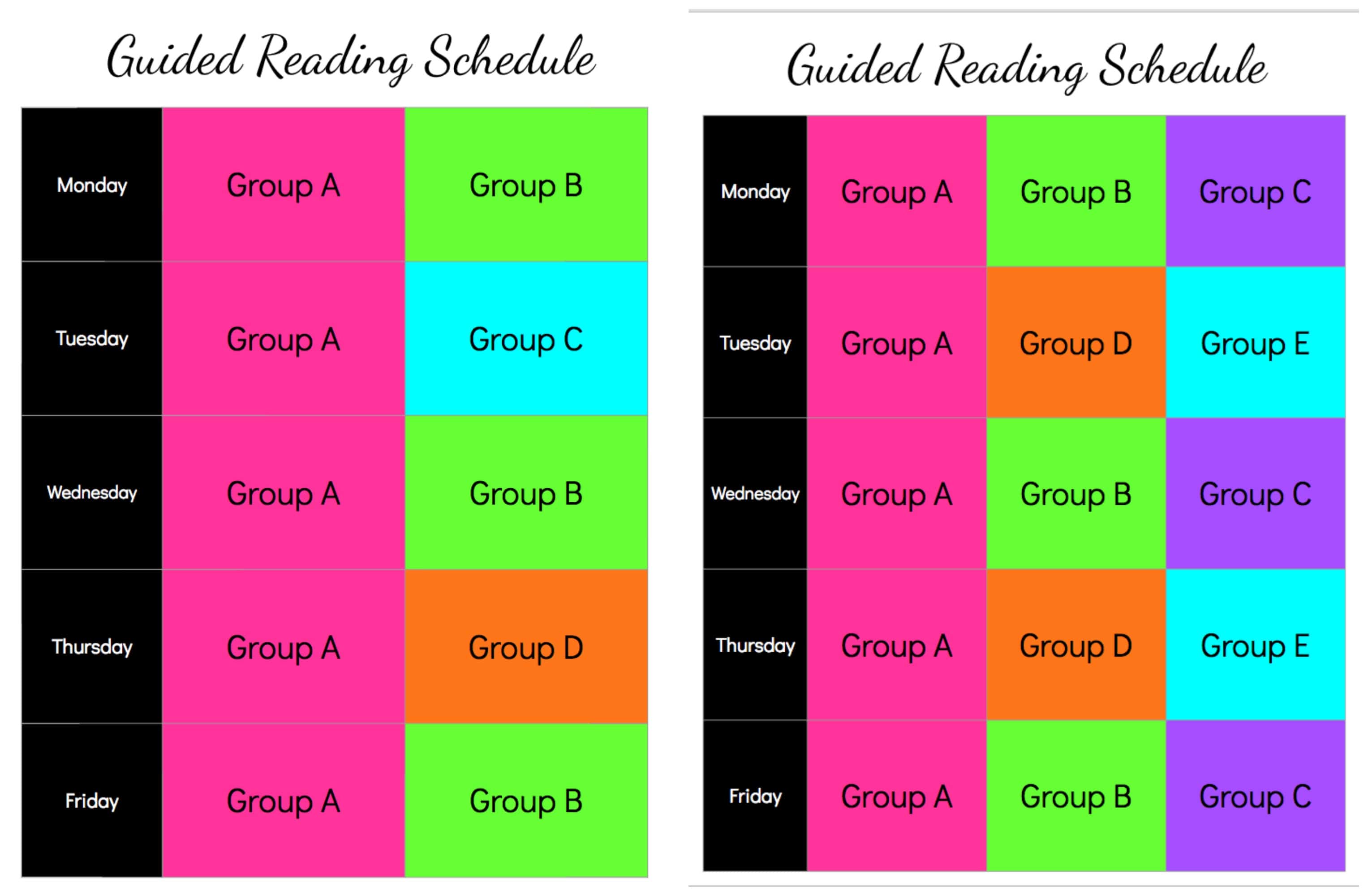
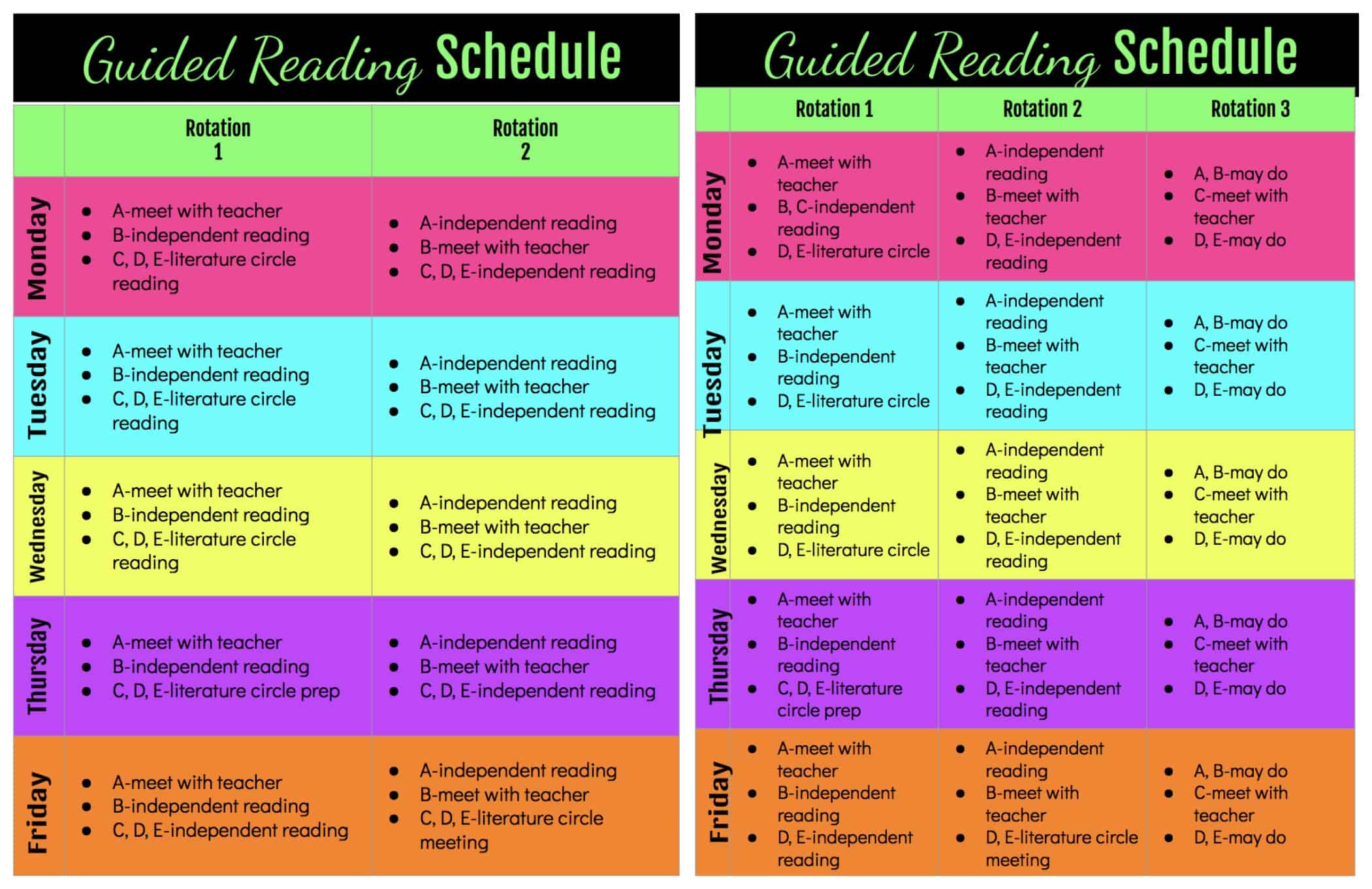
I typically have at least one reading group of students who read significantly below grade level and one group reading significantly above grade level. It’s certainly not unusual for a fourth grade teacher to have students reading on a first and second grade reading level. It’s also typical for that same teacher to have students reading years above their current grade level. I’ll address what I do with those groups first and then move to the students who fall in the middle.
Guided Reading –Significantly Below Grade Level
When you have students reading multiple years below grade level, it is essential to diagnose what is creating the difficulty for these students. This should be done before planning your guided reading groups. Yes, students should receive RTI or MTSS services, but that’s a different post.
I almost always start with a phonics screener to discover any phonetic gaps. The majority of the time, you’ll find that these students have a need for phonics instruction. You can use this screener for that assessment. In addition, be sure to check each student’s mastery of sight words to see if that could be contributing to their difficulty in reading. I use students’ results from sight word screener to assign each student five sight words a week.
Since these students are reading significantly below grade level, fluency will also be an issue for the group. However, don’t make fluency the primary focus of your instruction. It’s essential that students know to decode effortlessly to become fluent readers. Limiting instruction to only fluency practice will not give students the tools they need to become fluent readers.
Try to tailor your guided reading group’s instruction to that group’s specific needs. Below is my example lesson plan for teaching long a with a silent e. It’s nothing fancy, but it works. You can download an editable version here. I left it in an editable format, so you can adjust and copy/paste as needed.
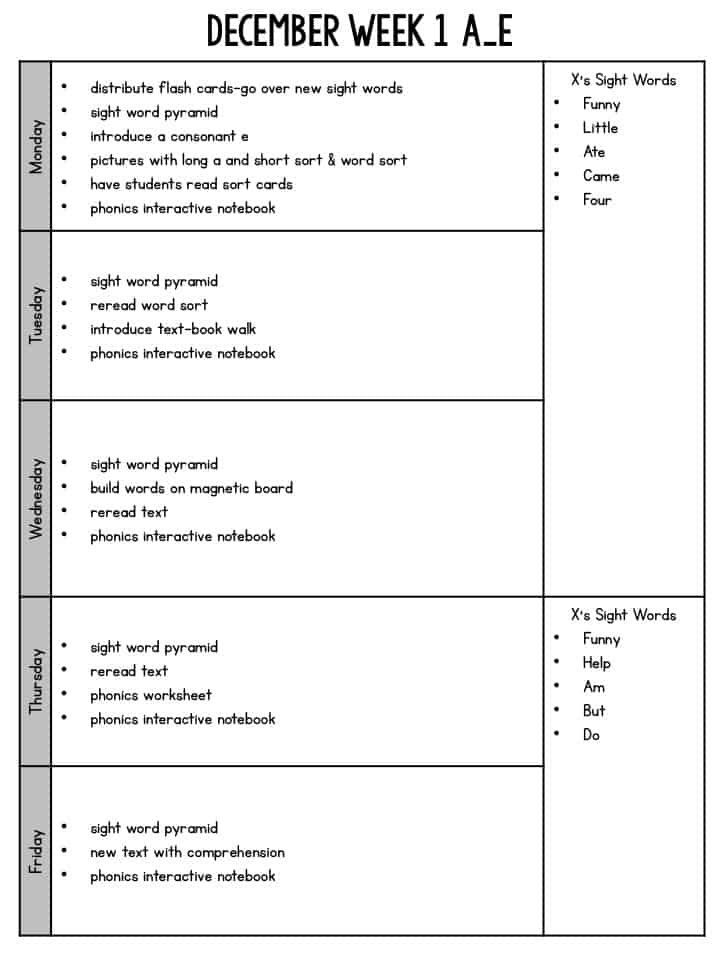
Below is a weekly overview of what we will do each day of the week.
Guided Reading – Monday
On Monday, students make flash cards for their new site words that they can take home to practice. To build in a little fluency and sight word practice, I have students read the sight word fluency pyramid cards. We do this each day with their individual sight words. It’s good to have students practice sight words in context. I bought these cards from The Moffatt Girls here.
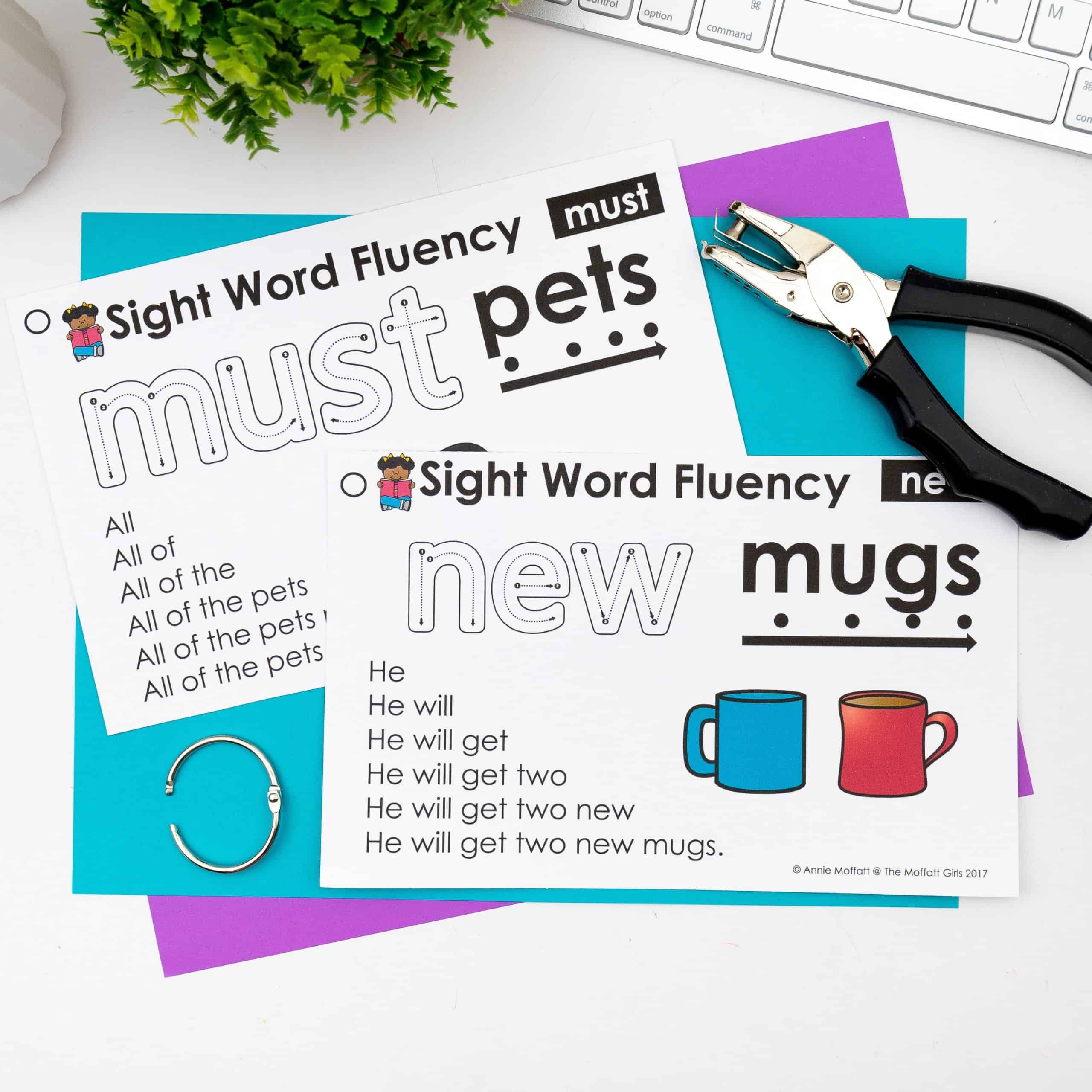
I then introduce the focus for the week. In the week shown below, I taught how the silent e changes the sound the a makes. We start with a picture sort with short a and long a sounds. You first want to make sure students can hear the difference between short a and long a. I bought this picture sort from Deanna Jump and Deedee Wills here. After students sort the pictures, I have them complete a word sort. Have students read each word out loud as they sort the words into either long a or short a. Some students may pick up on the pattern very quickly, but this may also be very challenging for some students.
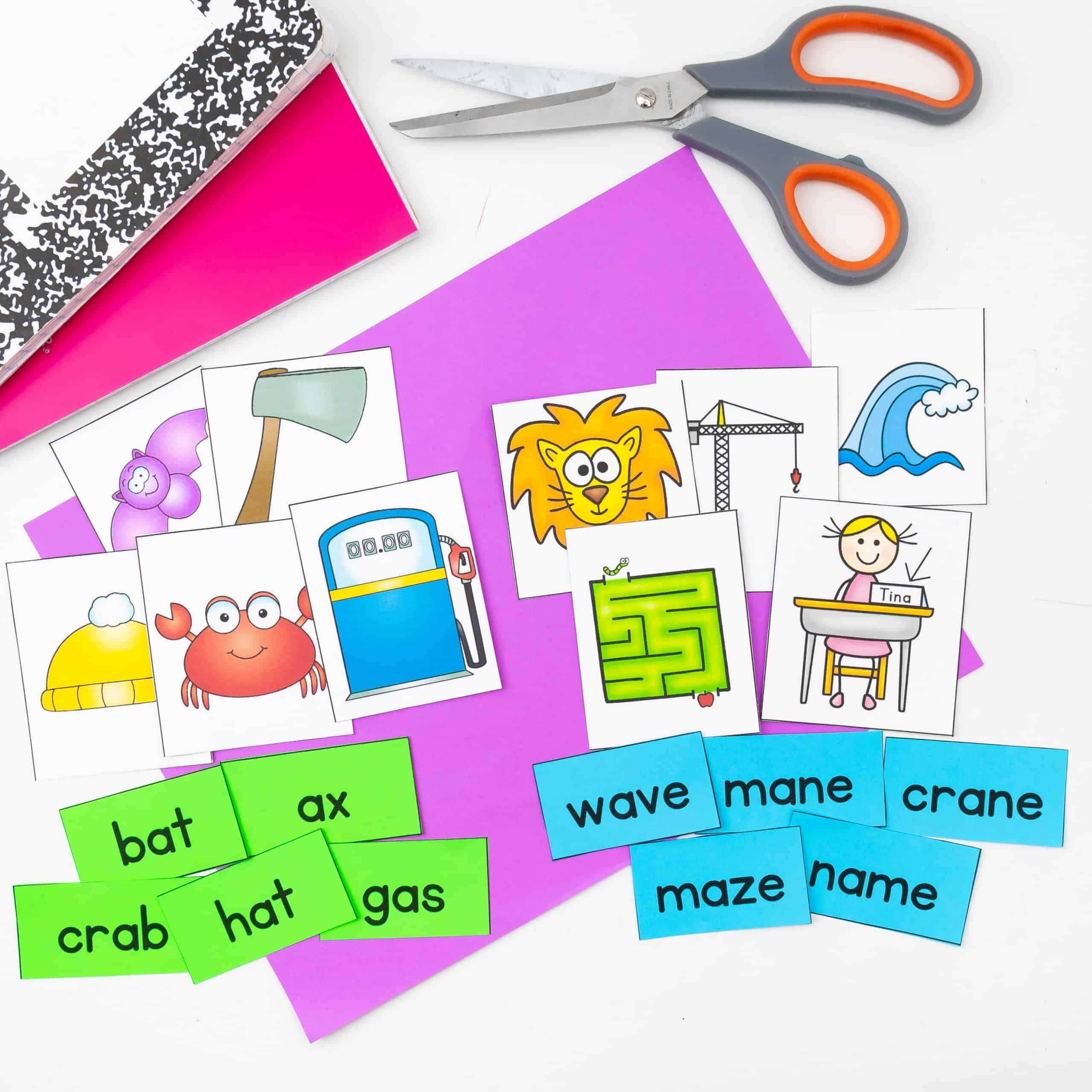
I typically end the lesson by having students complete an activity for their phonics interactive notebook. If I’m running short on time, I have students finish this independently while I meet with my next group. This is what I do for the group’s word work, which is different from my other groups.
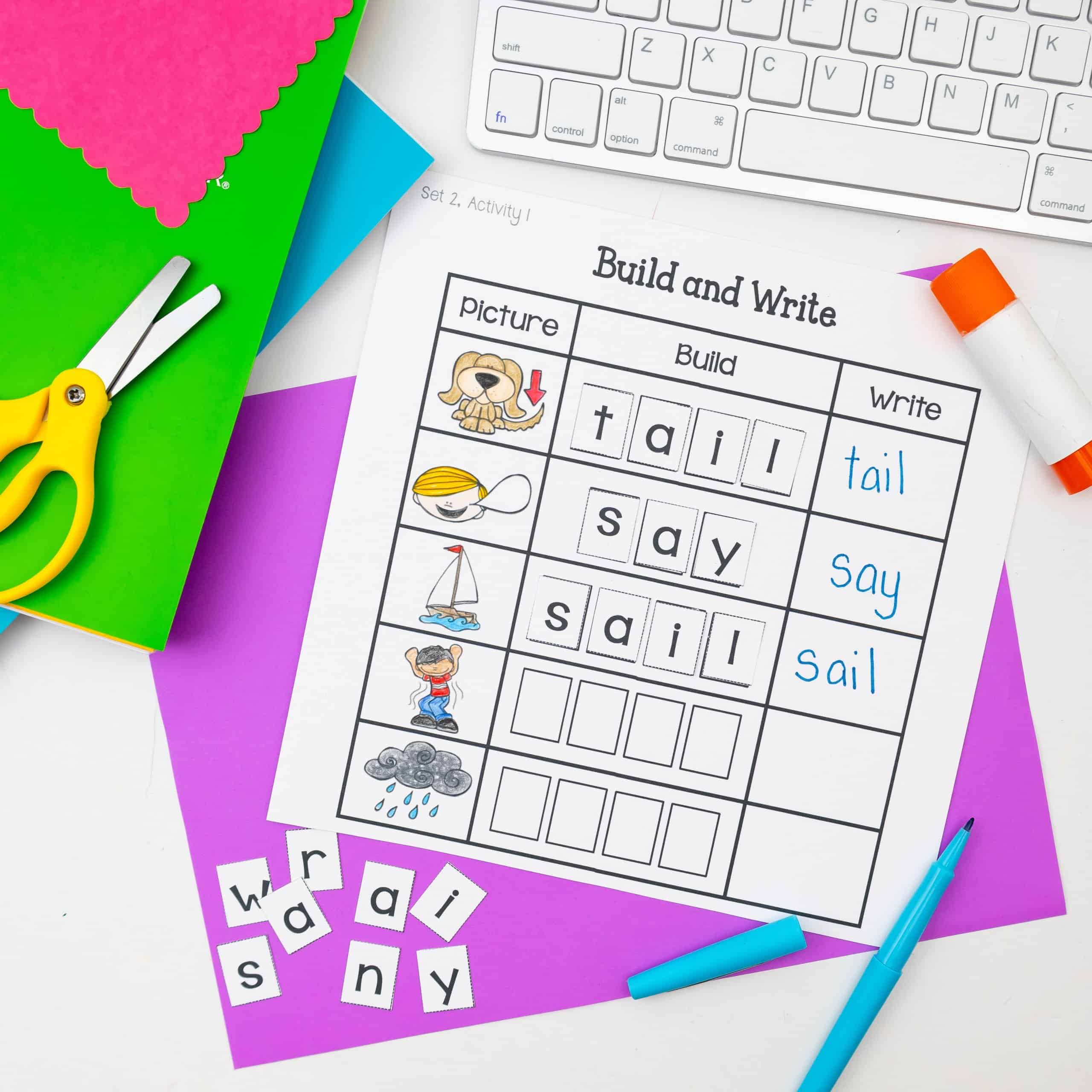
Guided Reading – Tuesday
When we meet on Tuesday, we quickly run through the sight word pyramid and review the words on the word sort (if needed). Then, I introduce our text for the week. I like using decodable books with a focus on the phonetic pattern we are studying. Are great resource is the decodable books from Reading A-Z, but there are many other options.
We take a book walk through the book, and I point out key vocabulary. How we read the book depends on the students in the group. If it’s necessary, we may echo read. I’ll read a page, and then the students reread the page after me. If students are stronger with the text, I may have them read it independently at their group and then reread it out loud to me. Students will then go through the book and highlight all of the long a words or circle words they don’t know.

During students’ work time, they complete another page of their phonics interactive notebook. In this activity students sorted words into long a alone and a consonant e.
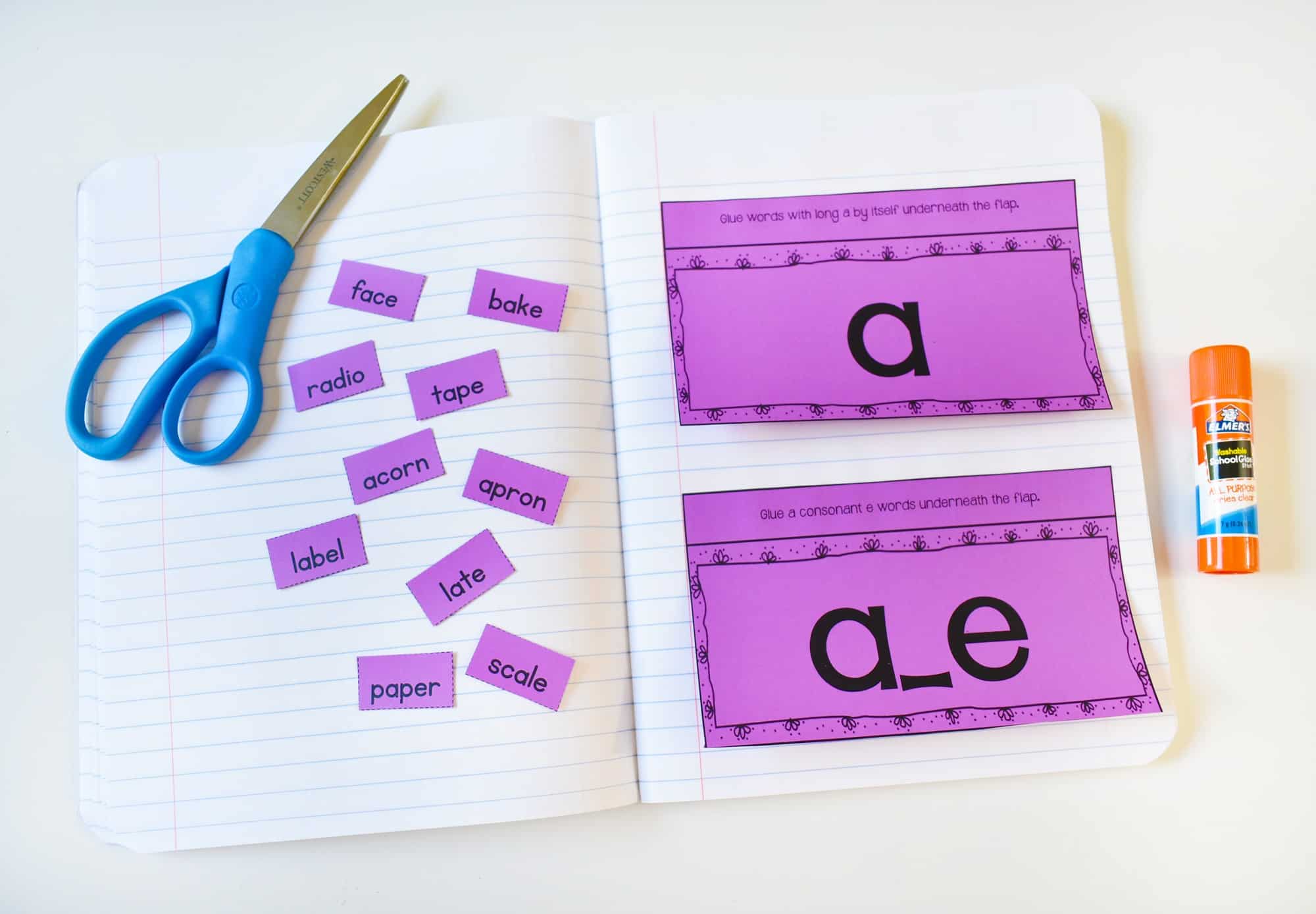
Guided Reading – Wednesday
By Wednesday, we quickly go through the sight word pyramid and reread the text. Students thoroughly enjoy partner reading the text, and this repeated reading is great for building fluency.
I use extra time for word work on our white board. On the board, there are magnets for all consonants, vowels, vowel patterns, digraphs, and some consonant teams. I only use sounds that I have taught, and we work together to physically manipulate words to build different words. This is an excellent tactile lesson for students and is particularly useful for students with specific learning disabilities. You can make your own magnets, but to save on time I purchased mine here.
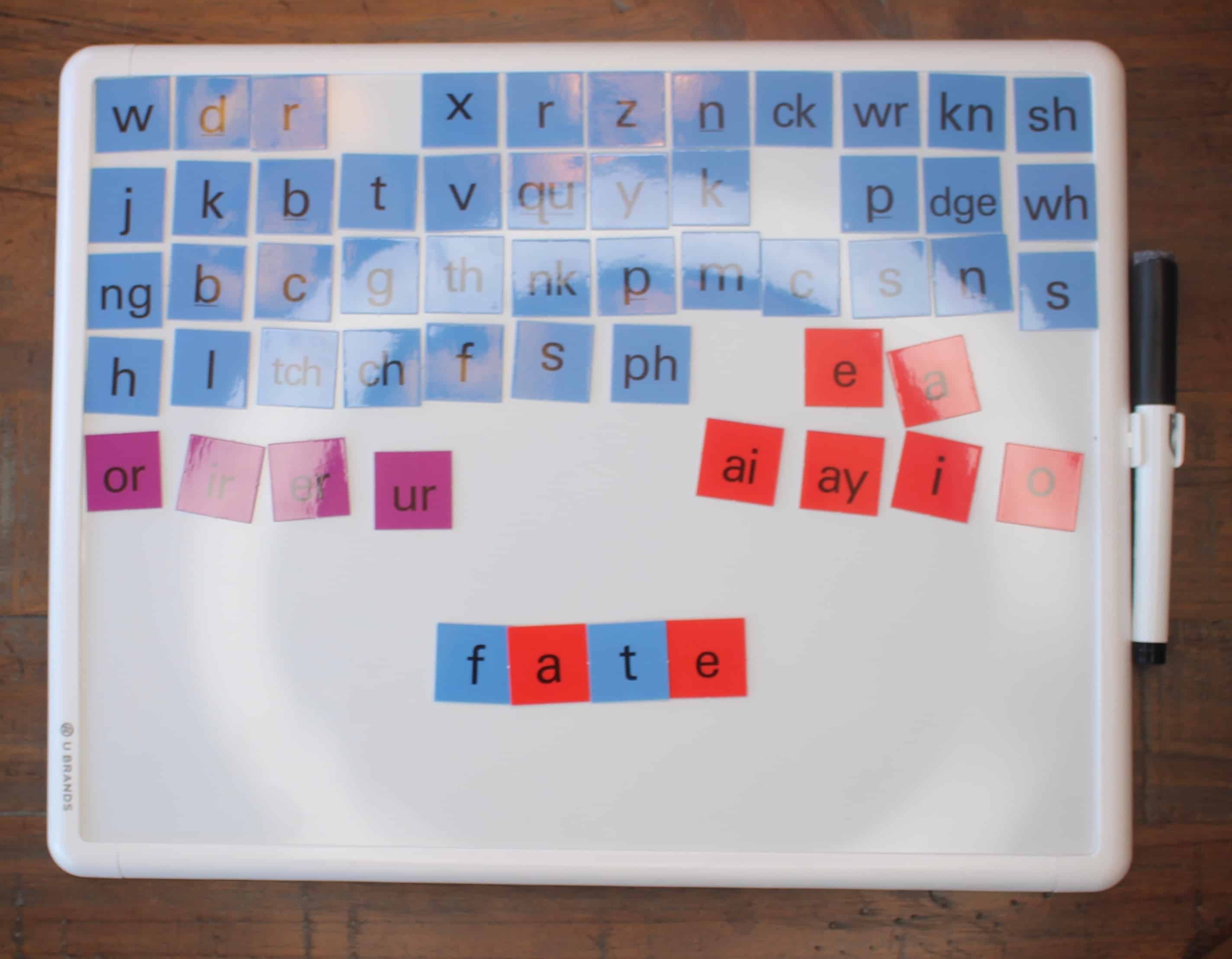
As a follow up to the lesson, students work independently in their phonics notebook. In this activity students spell a consonant e words. That is followed with independent reading.
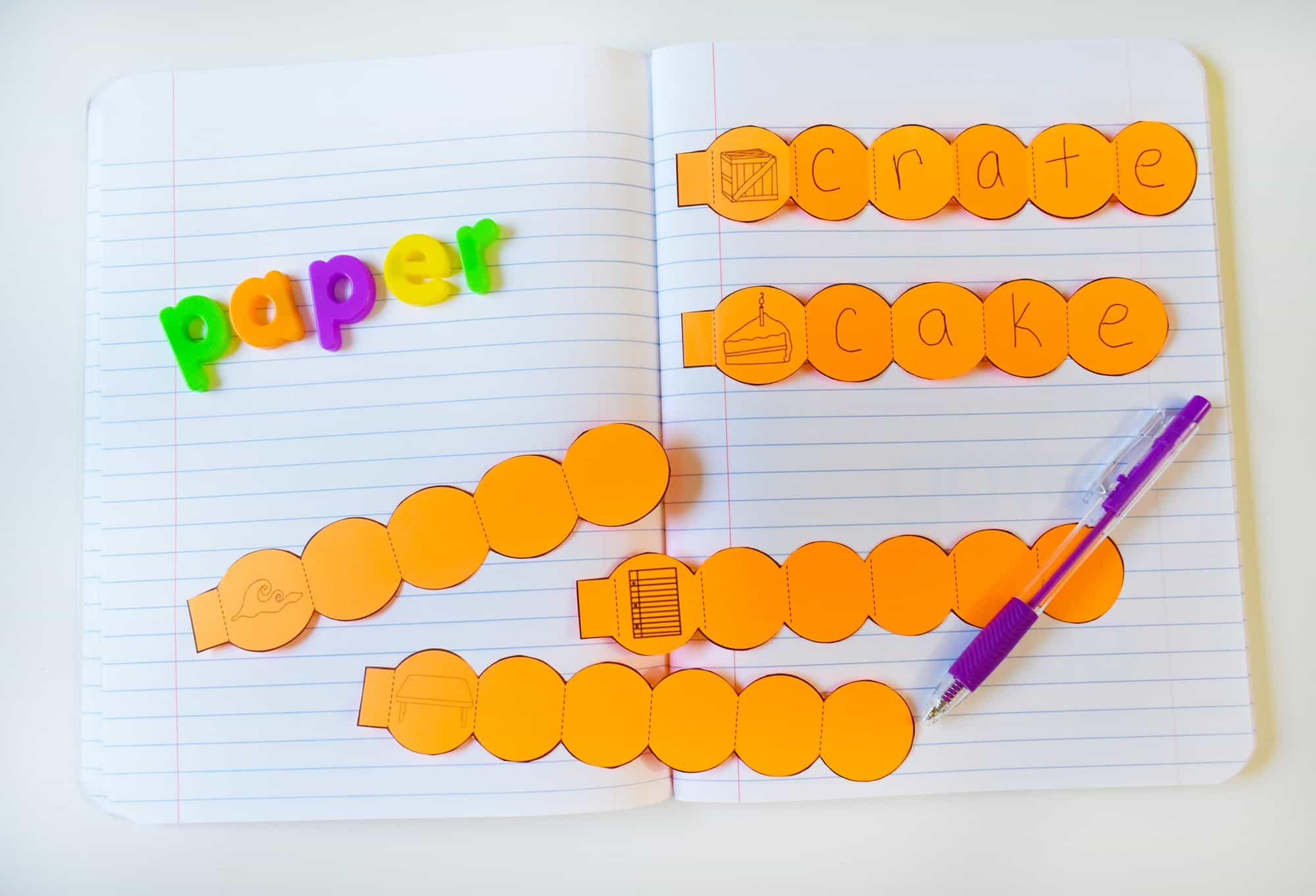
Guided Reading – Thursday
On Thursday, I reteach as needed. If I feel like students are ready, they complete a more formal assessment that address the phonics pattern taught and comprehension. This is from my Spelling Patterns resource, and it’s a great assessment and practice tool.
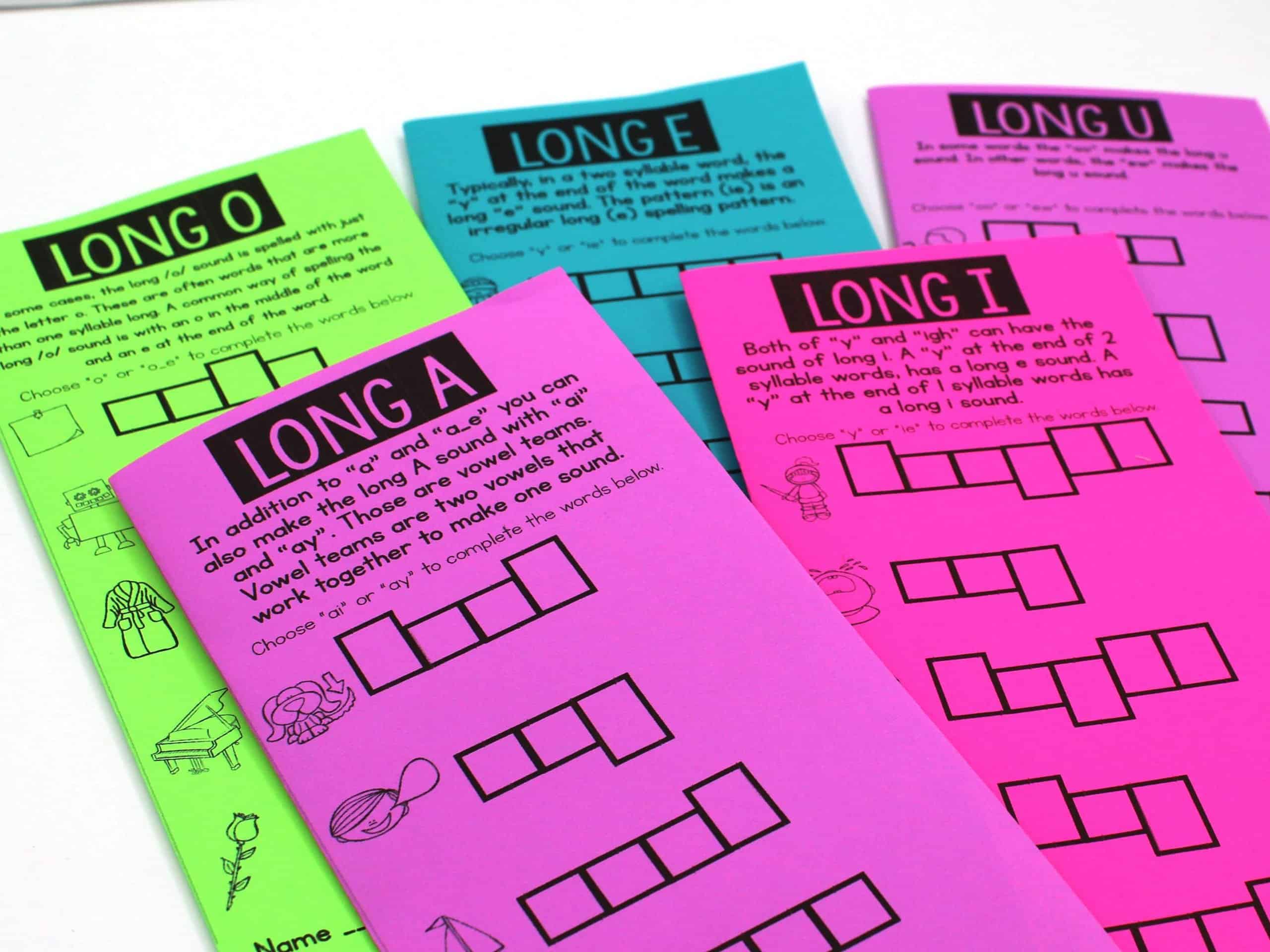
If that is too challenging for the group, I may choose a different comprehension activity from a different source.
Guided Reading – Friday
I use my students’ progress as my guide on when to move to a new skill or strategy. Some students may breeze through certain things quickly, while other students may need more than one week on the same skill. I often use Fridays for data gathering and progress monitoring. If possible, students can complete a digital assignment on Common Lit or Read Theory.
Fluency Practice
For fluency practice, I assign fluency practice as homework for my students in this group. I don’t assign the same passages as my other students, because they’re often not quite ready for the passages. Instead, I love using the passages from Miss Giraffe that focus on the phonetic pattern we studied. This gives students even more practice in context. It is important to expose students to grade level text, but I don’t do that during this part of students’ guided reading instruction.
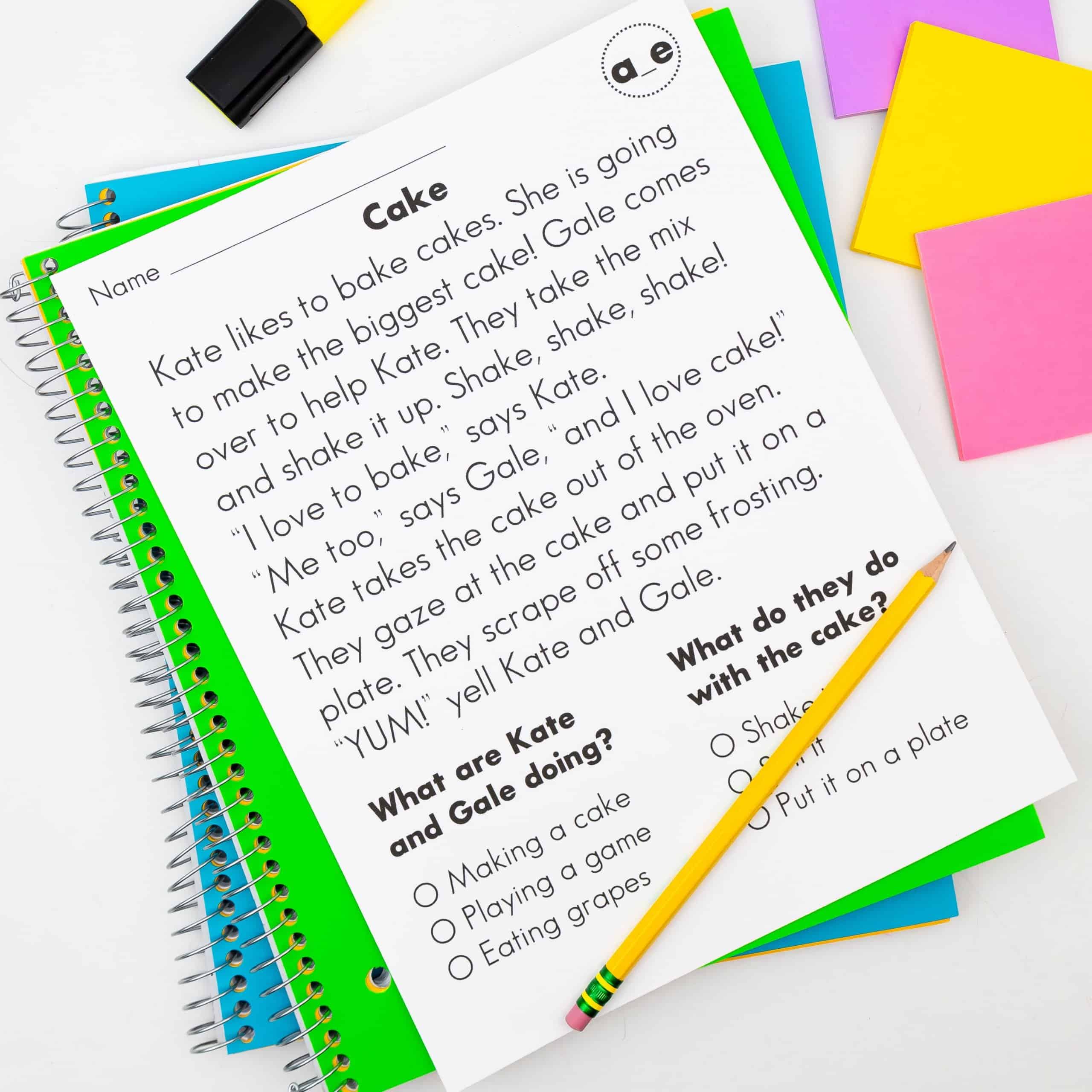
This is A LOT of things to keep organized! I have a 3-ring binder for all of my materials. I store all of the printables in pocket tabs, and I keep my sort cards in little sandwich bags. Finally, I store my lesson plans and notes in the binder.
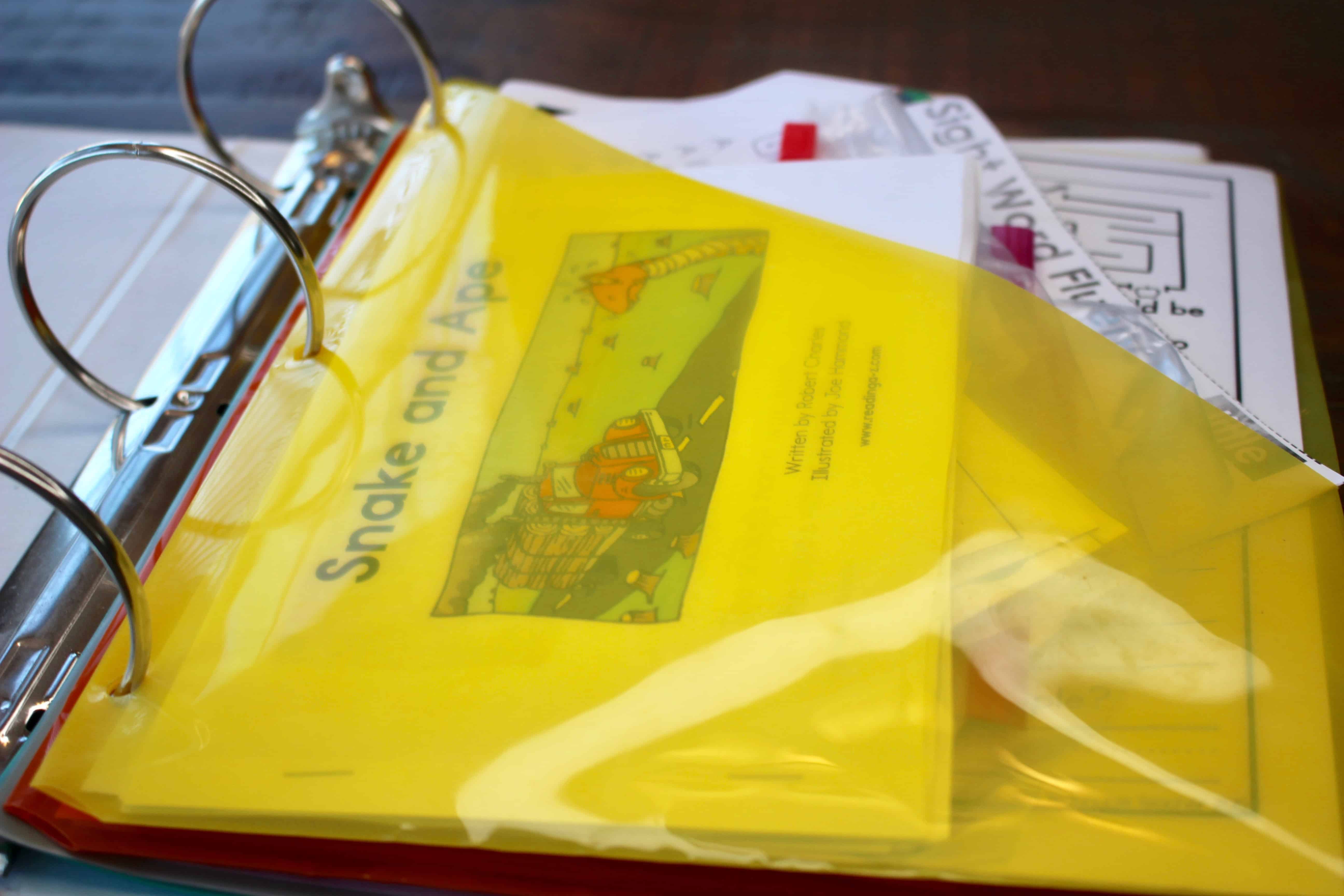

Guided Reading – Significantly Above Grade Level
Most teachers also teach students on the opposite end of the spectrum, and these students are reading and comprehending texts years above grade level. I have lost a considerable amount to sleep worrying about these students, because I don’t meet with them as frequently as I would like. I felt guilty that I was neglecting my highest readers.
Eventually I realized that while these students need me in a different way. They students don’t need instruction in how to read. They don’t need to work on raising their reading level. Instead, it’s my role to facilitate their love of reading and to challenge them to explore new authors and genres. Students should collaborate with their peers for authentic discussion and critique of quality literature. With these students, I like to implement literature circles and/or self directed novel studies.
I select five book options for our literature circles. The book choices are based on what I believe students will enjoy and include a variety of genres. Students list the top 3 books they want to read and one book they absolutely do not want to read. I use the questionnaires to assign each student a book for literature circles or a novel study.
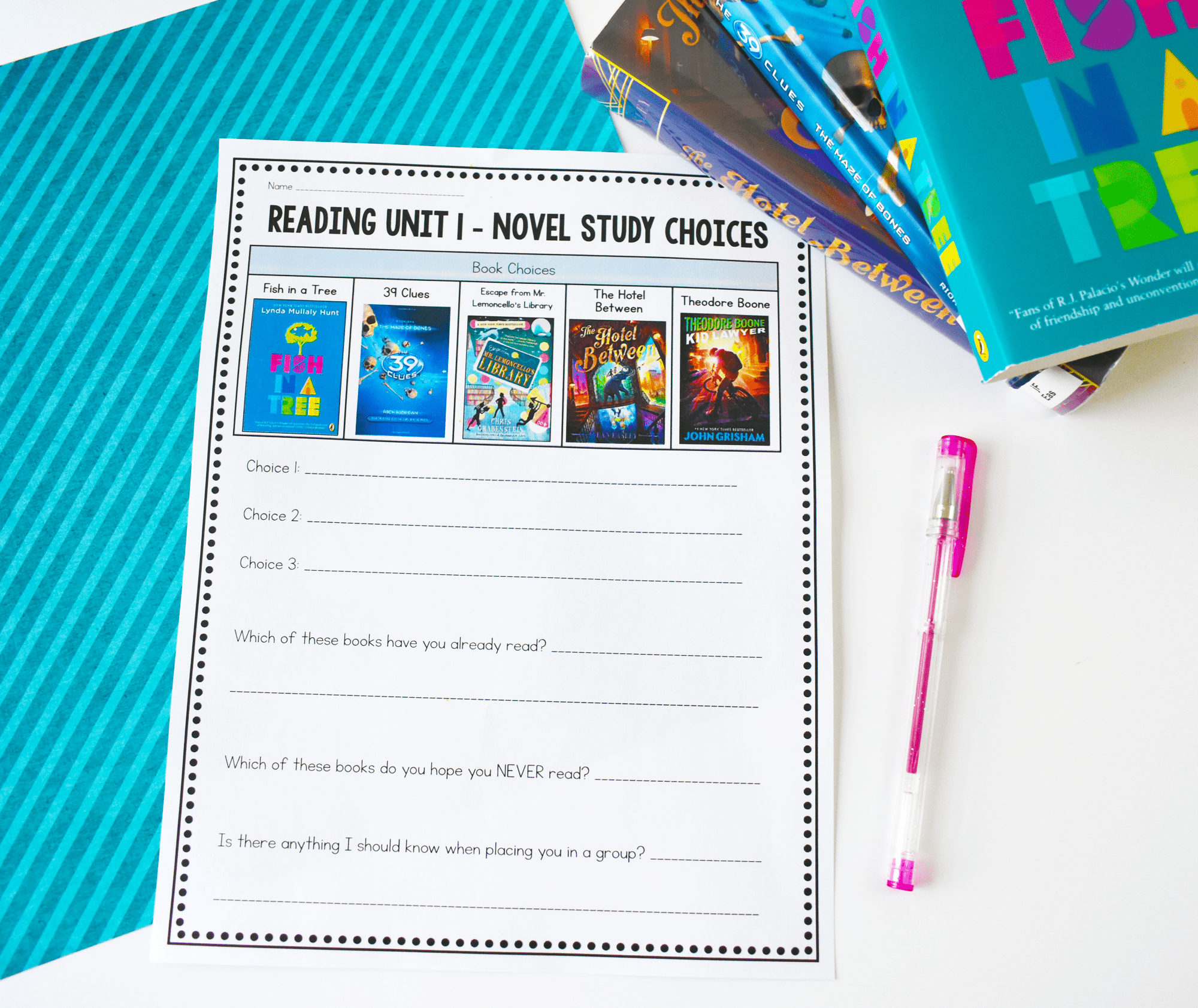
Each student has a literature circle planning guide, which lets students know which chapters to read each day. The guide also shares who has what role in the book club for the week. You can see an example planning guide below.
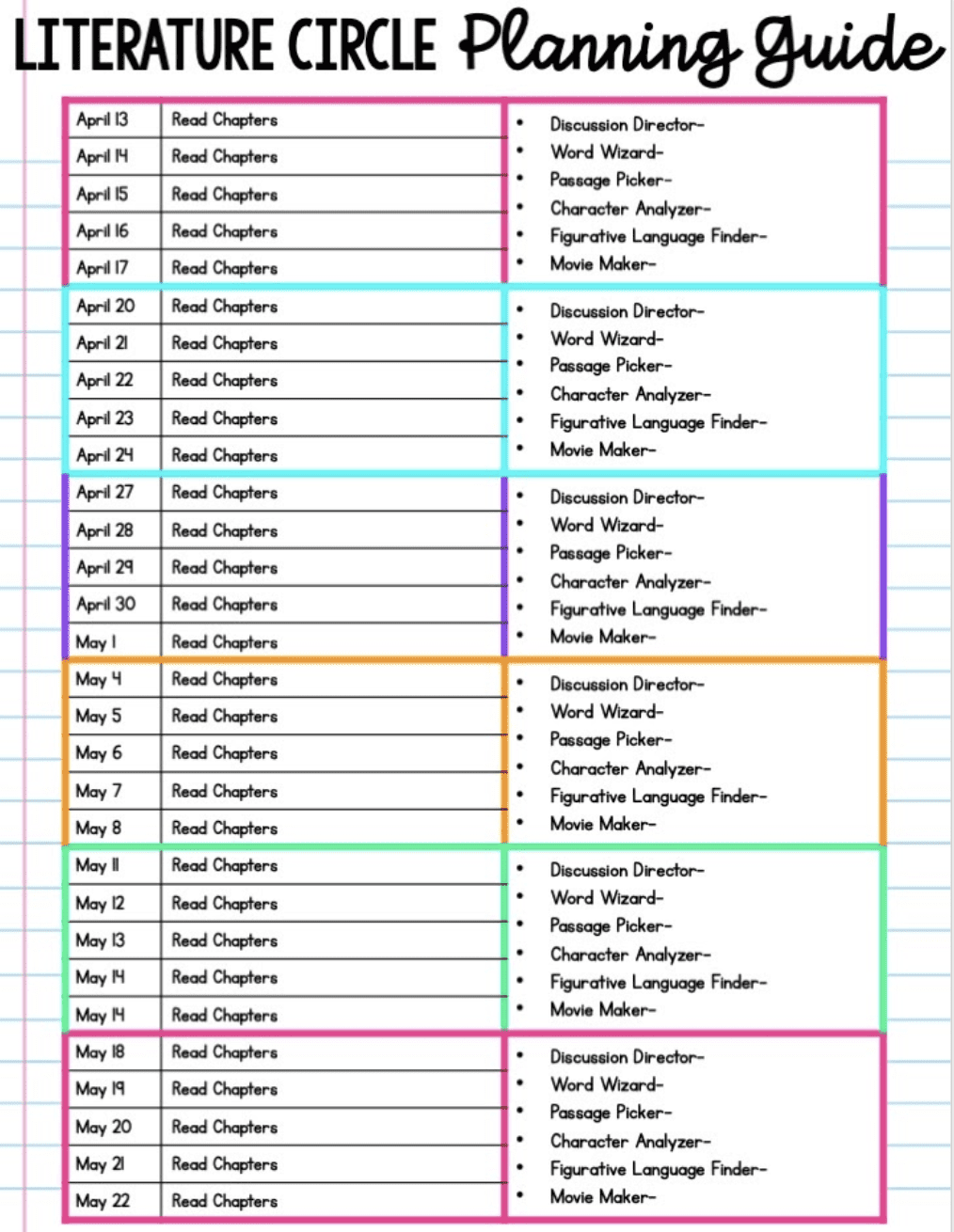
There are six different roles for students within their book clubs. If a group has fewer than six members, I would eliminate a role from that group’s directions. There should be a role for each student.
Discussion Director
The first role is the Discussion Director. The Discussion Director is the group’s leader for the week and writes six questions the group can talk about. They must write questions that allow discussion instead of questions that simply require a right or wrong answer.
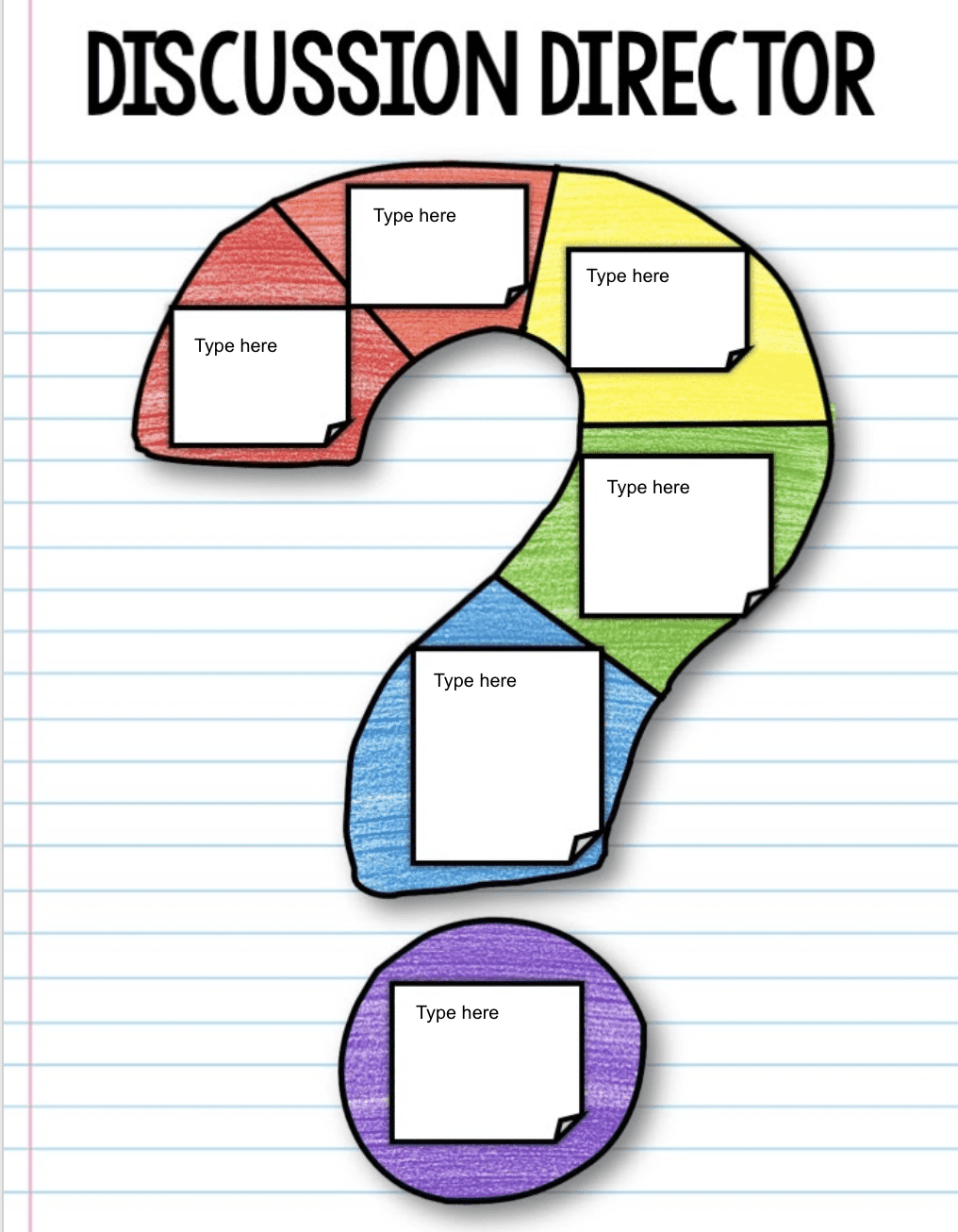
Word Wizard
The Word Wizard’s job is to find six words that they are unfamiliar with or that they find interesting from the selection that they read this week. As students read this week’s chapters, they use sticky notes to mark possible words. After reading all sections, they should choose your three words. Students write one one on each green text bubble. Underneath the word they write the page number and sentence from the book in which the word appears. In the blue text bubble, they write the definition and an original sentence using the word. At the weekly meeting, the student will share the words, as well as the sentence where they found them in the text.
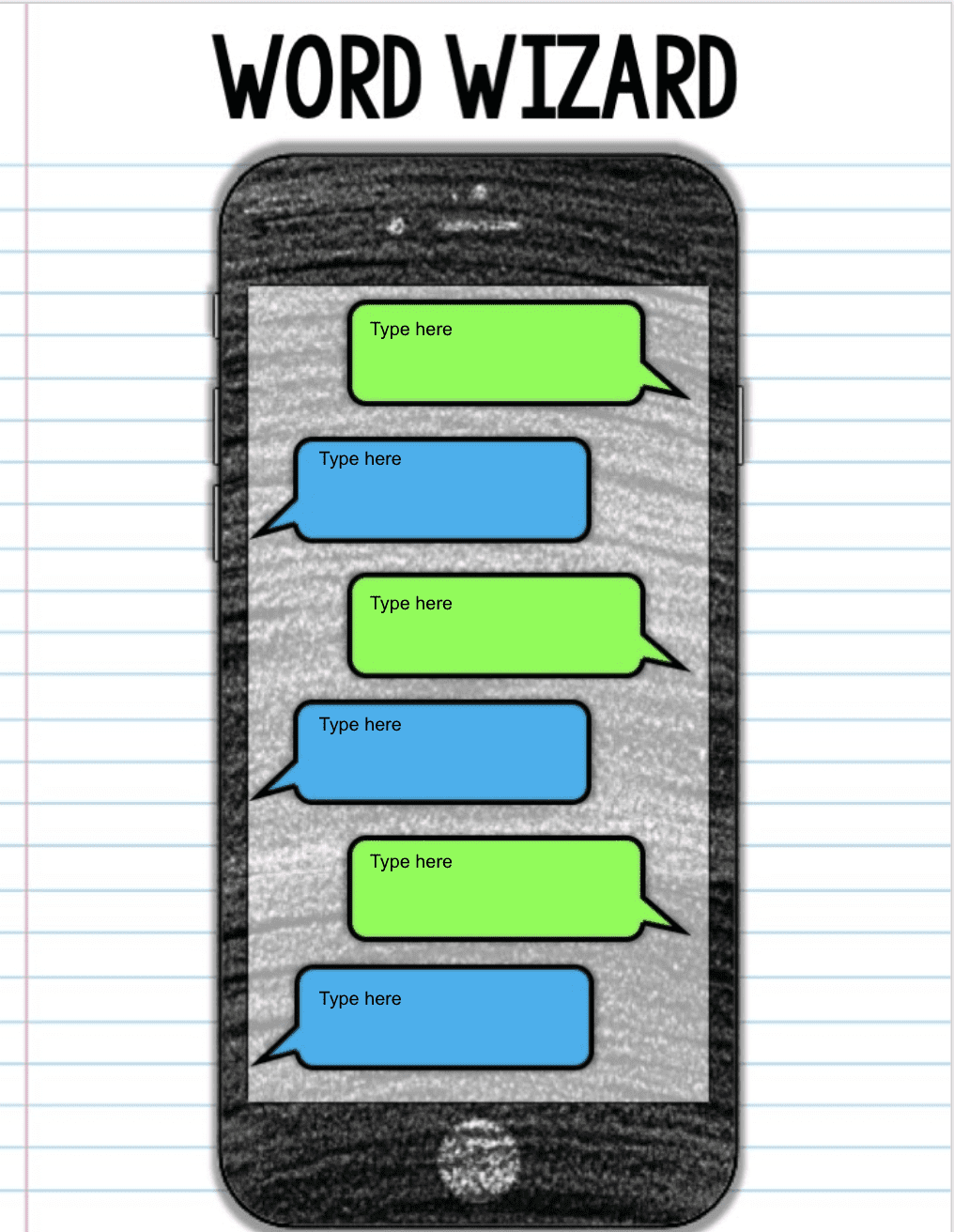
Passage Picker
The Passage Picker selects passages from the text they would like the group to talk about. They should choose passages that carry important meaning to the story. As the student reads, they should use a sticky note to mark possible passages that they would like to share. Eventually, they narrow down their choices to only two passages. Students type the passage and page number on the left side of the book. On the right side of the book, the student writes the reason(s) they chose this passage AND why they think the author included the passage.
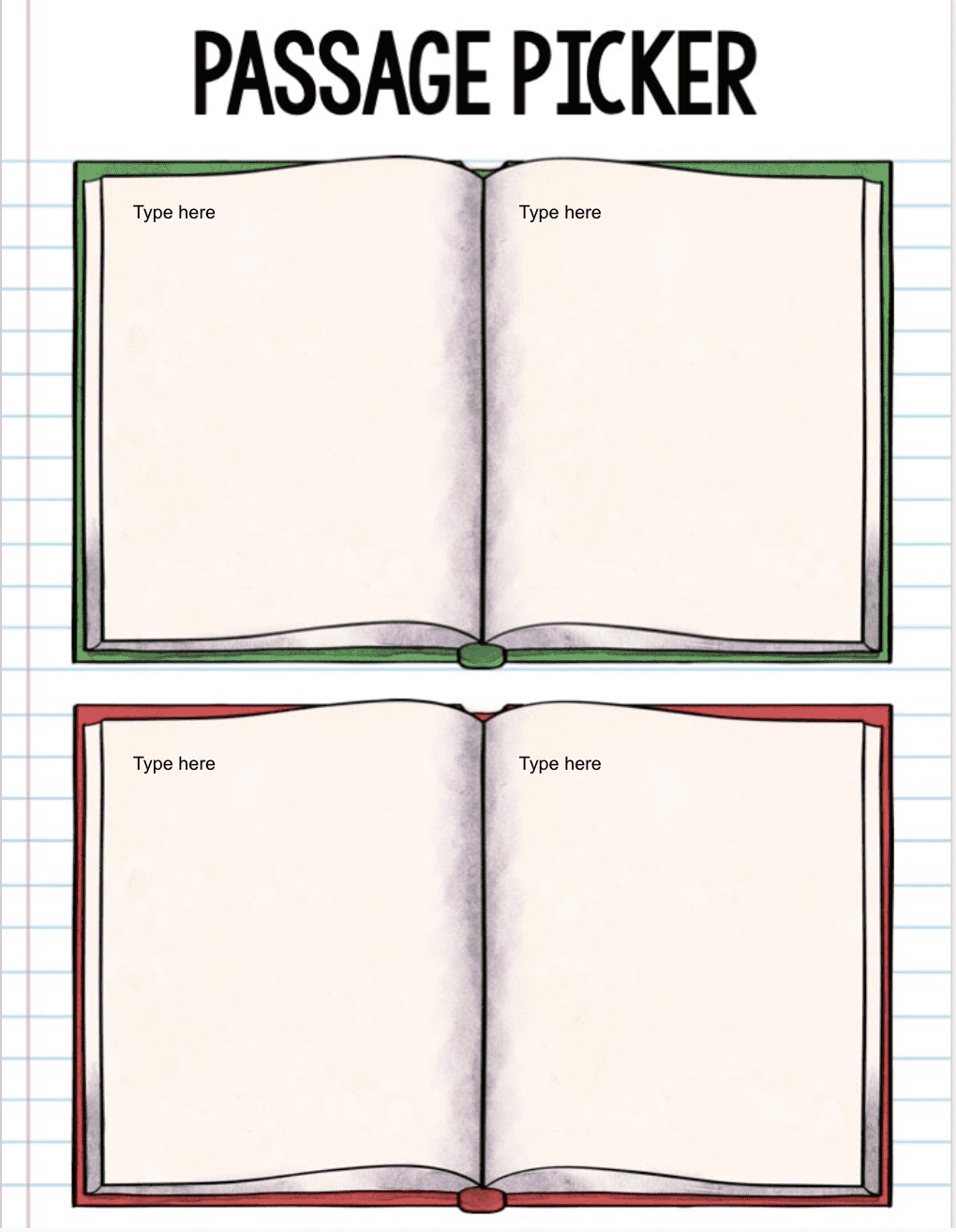
Character Analyzer
The Character Analyzer’s job is to find an interesting character from the chapters they read this week. The student should find four character traits to describe the character they chose. For each character trait, the student should provide proof, or an example, from the book.
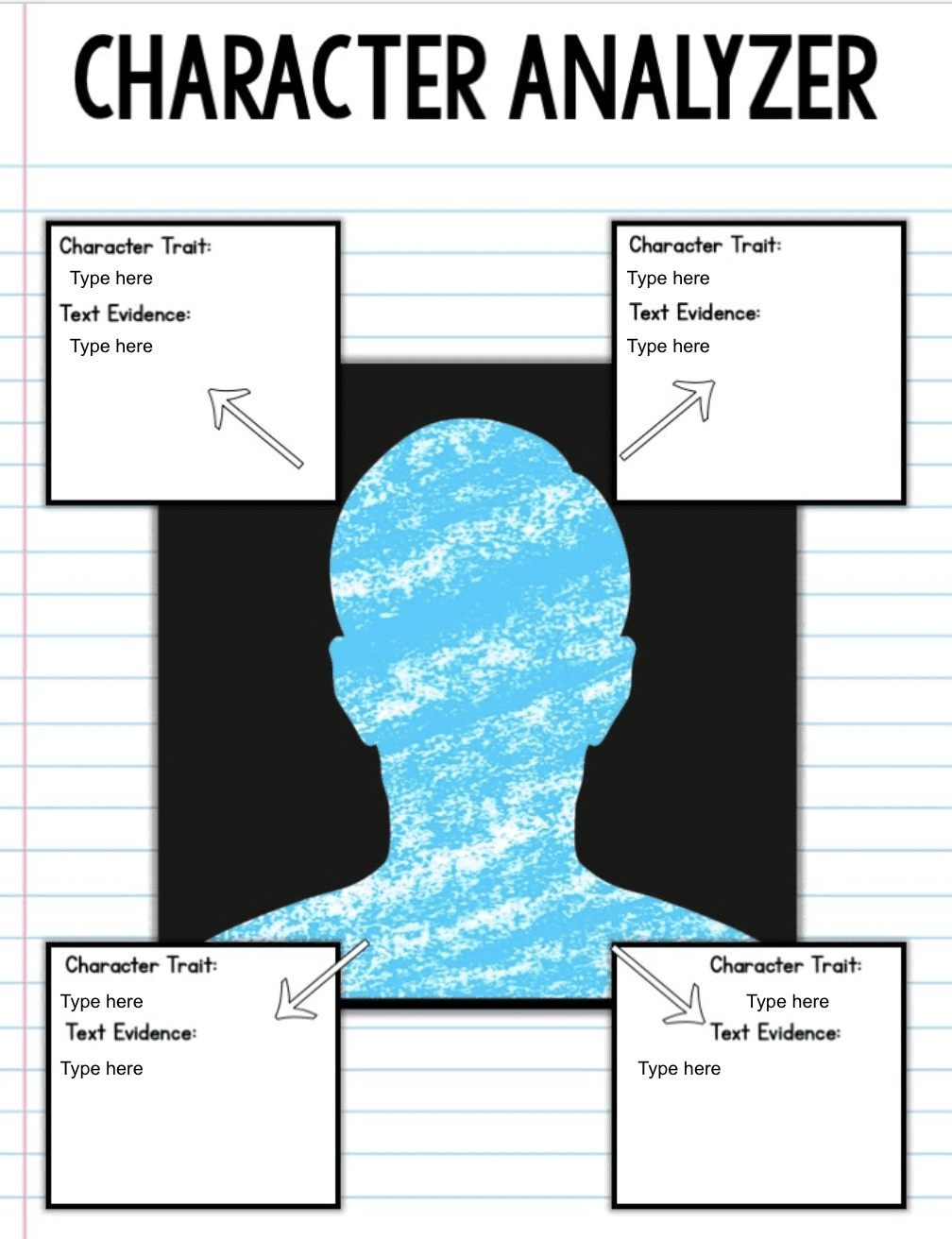
Figurative Language Finder
The Figurative Language Finder’s job is to find three examples of figurative language in this week’s chapters. As students are reading, they use sticky notes to mark examples of figurative language. Students leave the sticky notes in the book for the group meeting so you can easily find the examples. The Figurative Language Finder will write each of their examples in one of the columns and explain which form of figurative language each example is.
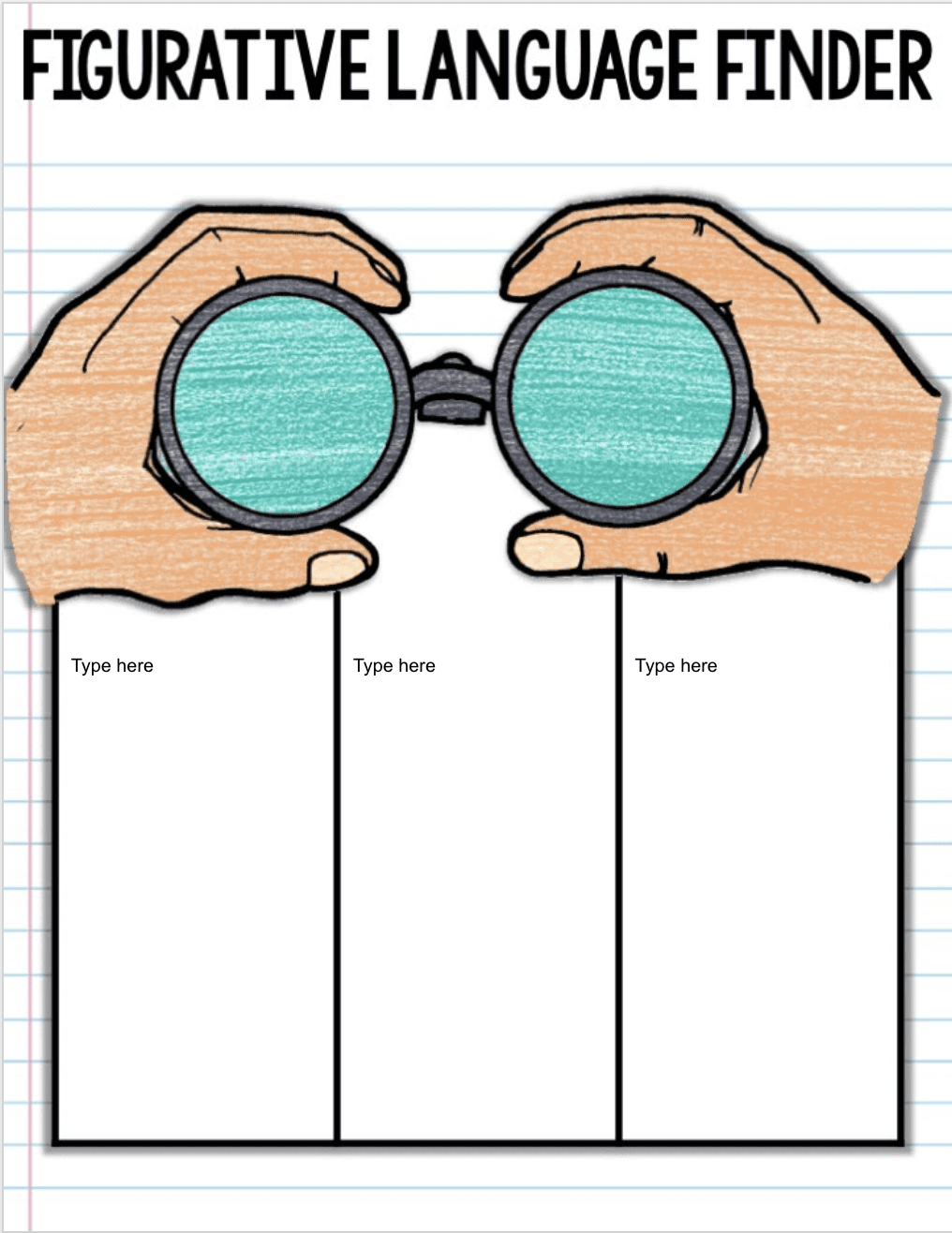
Movie Maker
The Movie Maker helps turn the book into five movie scenes. The student will identify five major events from that week’s reading and share how those events could be conveyed through a movie scene.
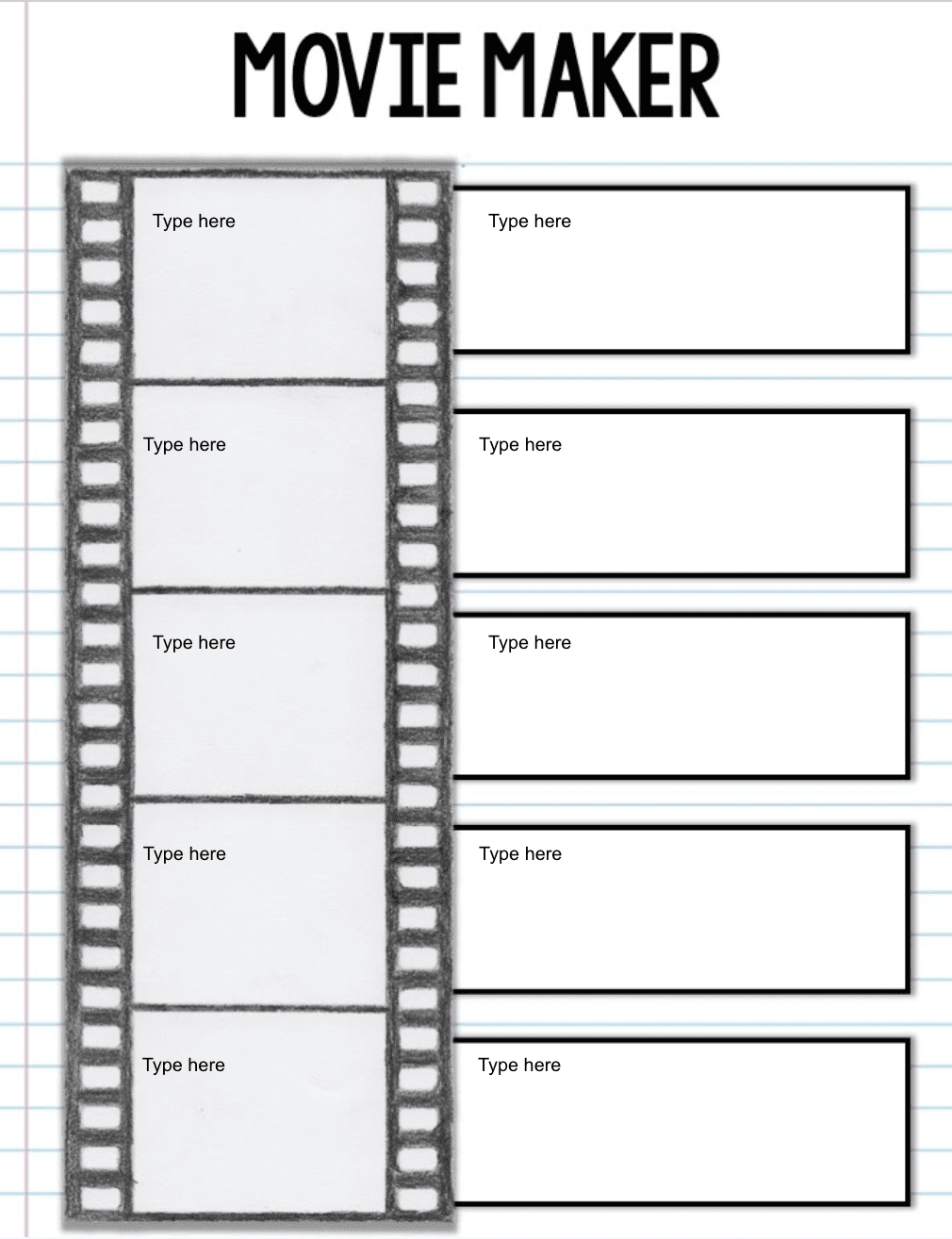
Students only complete ONE form a week. They ONLY complete the page/role they are assigned for the week. You can access the digital book club forms here!
It’s important to not allow literature studies to not replace students choice and ability to choose their own books for independent reading time. This should be a supplement, not a replacement. I’ve created five novel study booklets for each of my six reading units. You can see the first unit here.

Guided Reading Strategy Groups
The next group consists of students who are in the general grade level range-some may be a bit above or below. This is when I work with students in guided reading strategy groups. As with any group, it’s important to keep groups flexible and fluid. While I do take read levels into consideration, the emphasis should be on the strategy, not the level of the text. I
In my guided reading groups, I use books or texts that are not familiar to students and that are in students’ learning zones. Every student in the guided reading group reads the same text, so you need multiple copies of the text.
Leveled Library
At my previous school, we had a HUGE leveled library, so teachers could access all kinds of sets of books for guided reading groups. However, I no longer have access to a leveled library, so I print leveled readers from Reading A-Z. If I had a reading series, this is when I’d use my leveled readers. Since I use Reading A-Z, I try to keep it simple and print a complete lesson plan to go along with the text.
This has truly saved my sanity. I don’t use every single part of the lesson, because I don’t focus on grammar during my reading block. There are before reading questions to build students’ background understanding. Then, students preview the book by looking at the cover and illustrations. I then introduce difficult vocabulary and set the purpose for reading with either a reading strategy or skill. The lesson plan includes various stopping points in the text, so I have students read to a certain page, and then I model a strategy and we discuss different elements of the text. It usually takes me one 20 minute reading group to introduce a book and have students read the book the first time.
The second time the group meets, we revisit the comprehension skill and students partner read the text to build fluency. On the third day we meet, I love using the discussion cards for deeper conversations about the text. In those conversations, I require students to support their thoughts with text evidence.
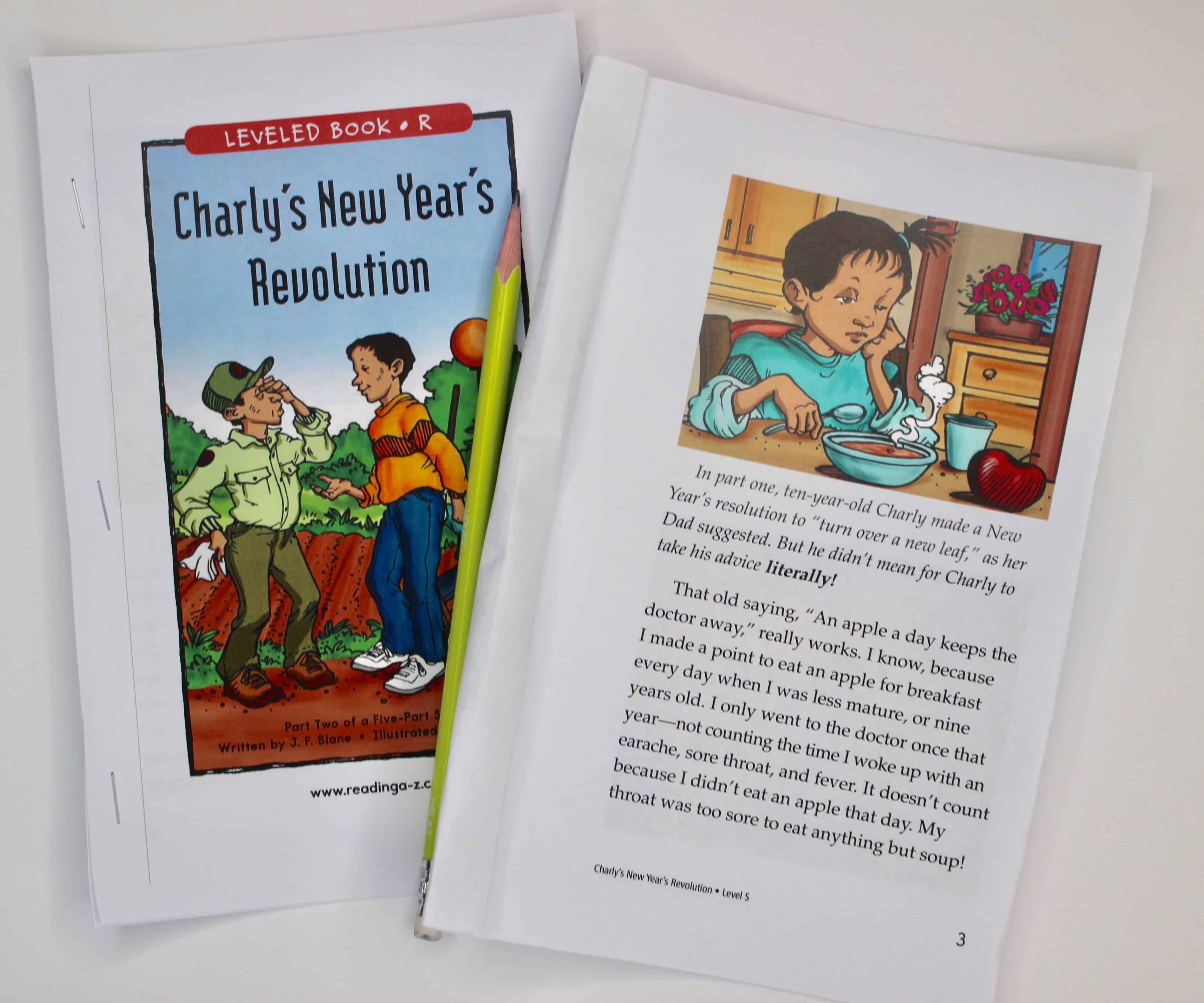
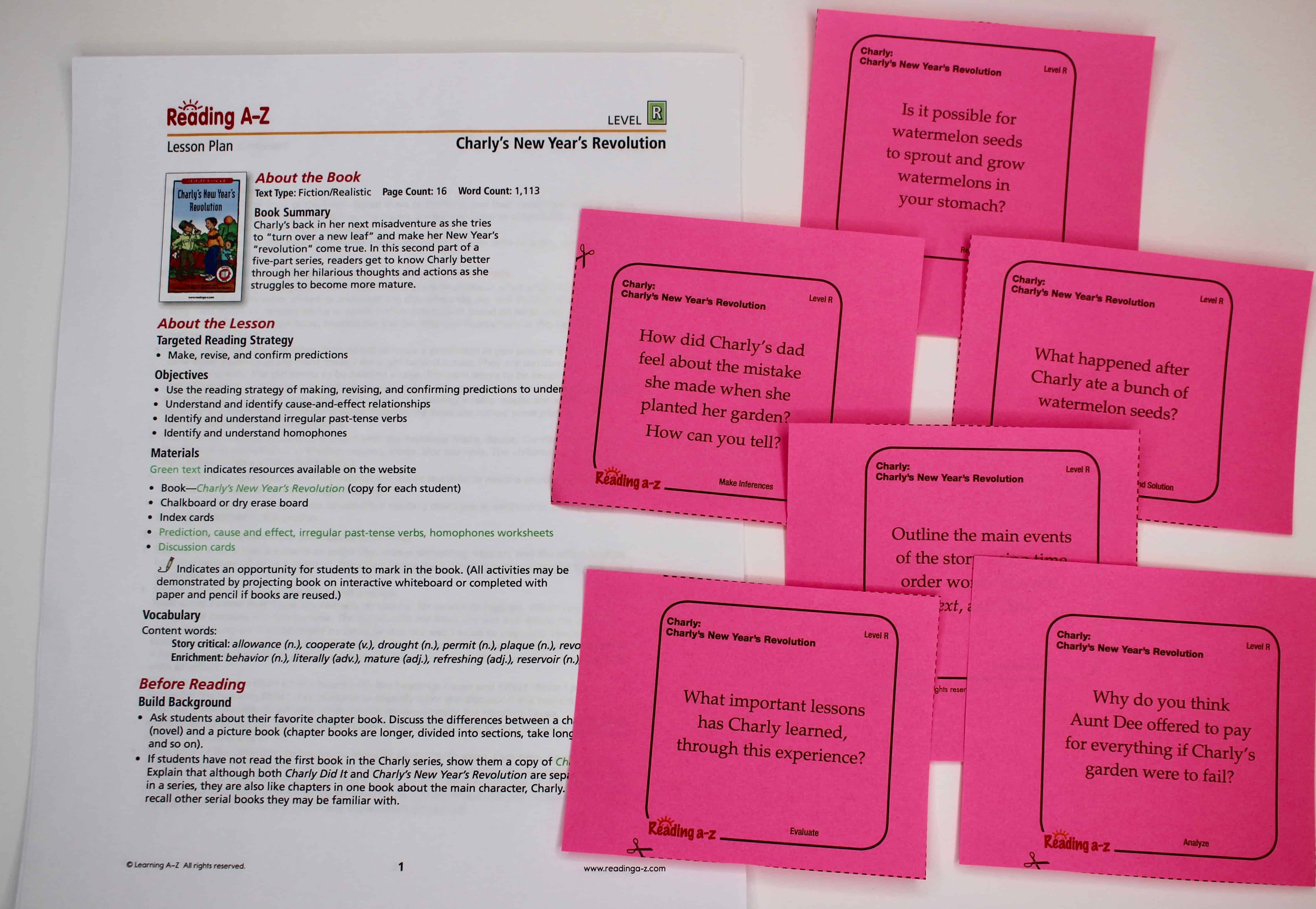
To help determine who should be in different strategy groups, I love using a daily reading practice assignment. I knew who my struggling readers were, but I needed a concrete way to determine which students needed additional instruction in which skill. You can use this Daily Reading Practice worksheet as a reading exit slip. At the end of my reading block, I give students the one page reading worksheet. The review includes a brief reading passage, two multiple choice questions, and two short answer questions. It is a very brief assessment, so students can complete it quickly.
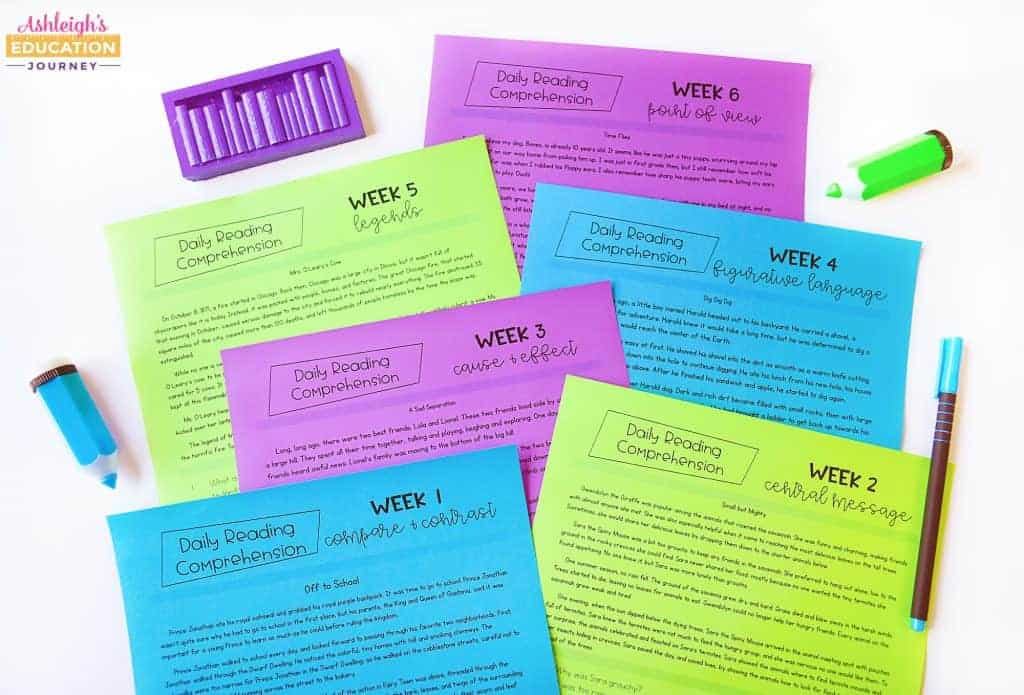
I use that information to determine who will work with me in a strategy group on that skill. I do not use these for grades as much as I do a formative assessment, because it’s a tool to monitor my students’ comprehension growth. When I work with a strategy group, I may use a printable from my reading workshop mini lesson. When I designed the printables, I created them so they could be used with any text. This allows me to transfer the content from my mini lesson to a small group. This also means that not every student will complete every printable, which is perfectly fine.
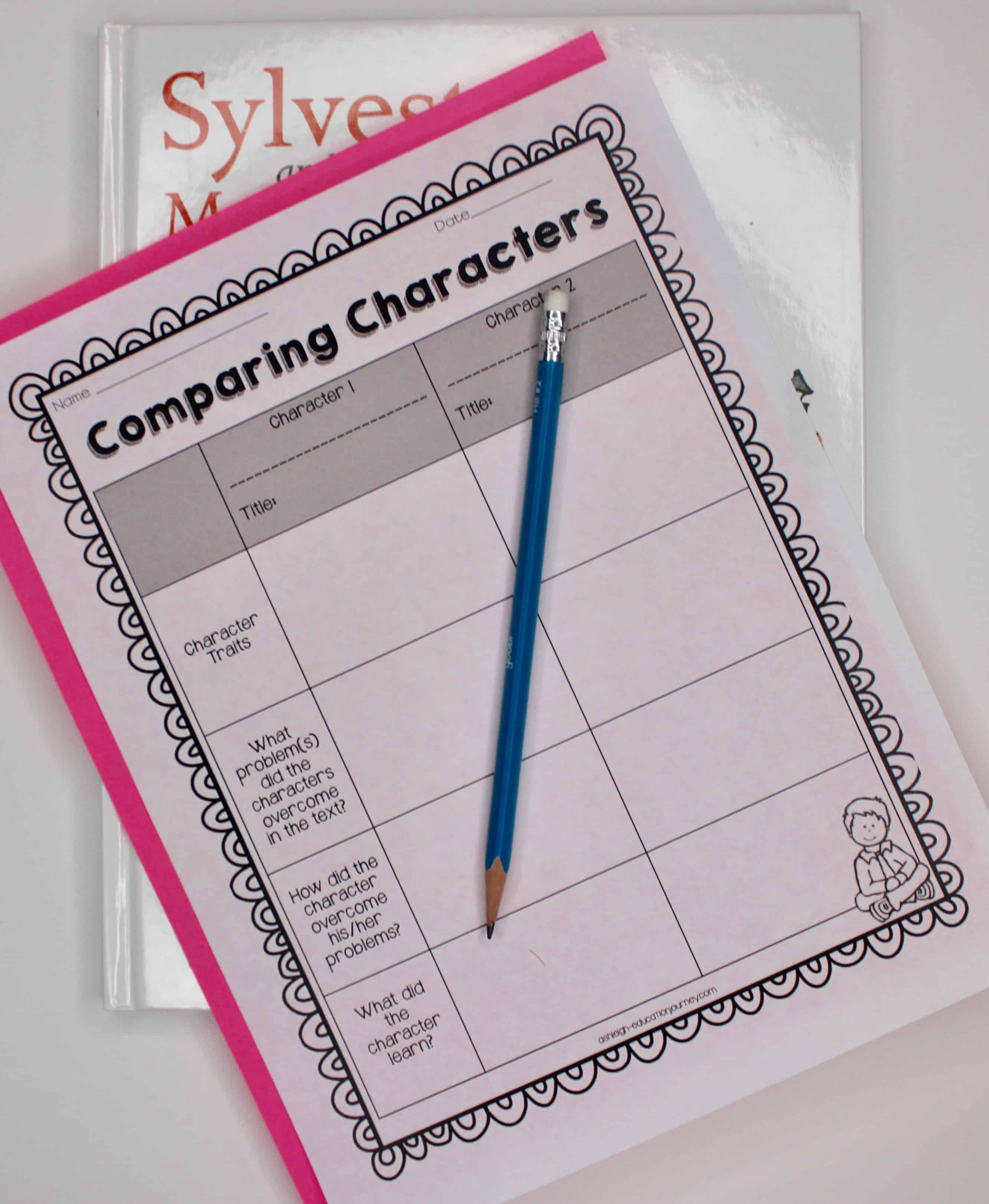
Wow, that’s a lot of information, and I’m sure I’ve left plenty of questions unanswered! What else should I add about guided reading?



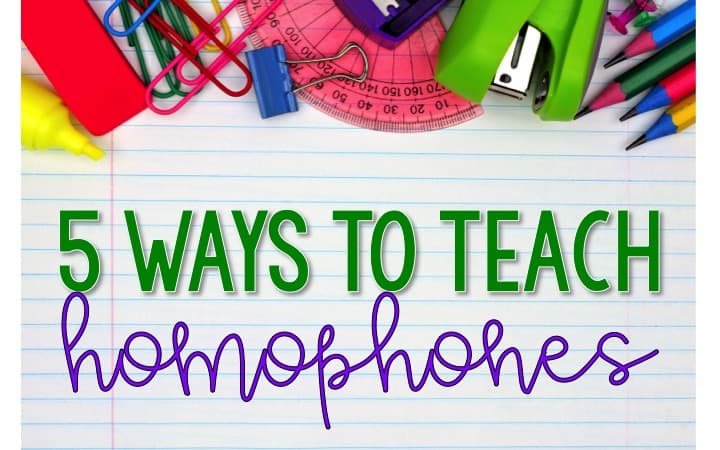
WOW! Ashleigh, I love this post! Thank you for sharing all of your experience. I will definitely be using this info to better organize my lessons.
Ashleigh, this post is an answer to prayer. Thank you SO much for this detailed post – pinning for future reference. 🙂
Thank you so much for the article to keep me going with a New Year! I think I will try a couple of things you suggested for January with my groups. I am going to have them write more in their guided reading notebook about the strategies we are working on.
Hi Ashleigh,
I loved reading about your guided reading practices. I would love to download the schedule template you use but it won’t open up for me. Could you send me the URL for the Google Drive one?
Thank you!
As usual, great post with tons of practical information!! I’ve purchased several of your guided reading units, including the new novel studies, and they are amazing resources! Can you share a link to the bookmark that you use for literature circles?
Thank you for sharing your guided reading schedule! Could you tell me how you let your students know what they will be doing each rotation? Do they have the same menu or do you have a larger one posted in the room for them to see? I would like for my students to have something to see so that there is no question what they are to be doing and when and it is very easy for them to access.
Thanks!
I display it digitally. Now that my students have the routine down pat, I don’t display it anymore.
Ashleigh, this is incredible! Thank you so much!!!!!! Even though I’m in my 21st year of teaching, I’m always changing and currently switched to opening a teacher-led K-5 school. We teach students where they are at, not grade levels for each core subject. This will be so great! Thank you!
I love this post. Thank you for sharing so much info. Do you have your reading exit slips/ formative assessments for sale? I love the idea of using those to determine who needs more help with the current skill.
Yes, I do! Here they are: https://www.teacherspayteachers.com/Product/Daily-Reading-Practice-3rd-4th-Grade-3512377
I always love reading and rereading your blog posts! They are so informative and practical. How often do you do strategy groups a week? How do strategy groups fit in with your guided reading schedule?
I regularly mix it up. To be perfectly honest, a lot of time my strategy groups end up being the same as the lower guided reading groups, so the overlap makes it a little easier to plan for.
I downloaded your literature circle booklets and I love them. It doesn’t include the passage picker. Is there a link to a TPT to purchase the rest of the booklet? Thanks so much for this awesome resource!
I actually didn’t use that role in my class. I need to add it for those that do!
Ashleigh,
Thank you so much for this post!!! It’s a life saver as this is my first year teaching 5th and first year teaching ELA. I was previously a middle school math teacher!! The link to the screener isn’t working. Would you be able to send it to me or send me a new link?
Again, thank you for taking the time to write this blog!
Wonderful article and so descriptive. I tried to follow the link for the phonics screener, but it seems that it is no longer available. Do you have that screener (or another that you use) that you could share? Thank you so much!
Hi Ashleigh,
I have purchased your reading workshop bundle and enjoy using it. It really helps me focus my lessons as I am a first year teacher. I have read a lot about guided reading groups and strategy groups, but I am still a little confused. In the guided reading groups, do you only focus on comprehension as opposed to the standard being taught in the whole group mini lesson? Also, do your students seem to get enough practice on the standard just from the mini lessons and their independent reading?
My guided reading groups really depend on the students. I have some groups that need phonics instruction, some who need more scaffolding with the comprehension skill taught in the mini lesson with an easier text, some he need more general comprehension, and several other things. I try to keep these groups very fluid and flexible.
Wow! This is so helpful! Do your literature circles meet independently? How often do they meet in a group?
Yes, they meet independently once a week. As they meet, I float from group to group and listen to the conversations.
Pingback: 23 Fun and Easy Guided Reading Activity Ideas - galaxyconcerns
Pingback: 23 Fun and Easy Guided Reading Activity Ideas - Emirates Education Platform
Pingback: 23 Fun and Easy Guided Reading Activity Ideas – teachersconnect.co
Pingback: 23 Fun and Easy Guided Reading Activity Ideas – Consumers Advisory
Pingback: 23 Enjoyable and Simple Guided Studying Exercise Concepts – independentweeklypost
Pingback: 23 Fun and Easy Guided Reading Activity Ideas – Heroes News Network
Pingback: 23 Fun and Easy Guided Reading Activity Ideas - Maryland K12